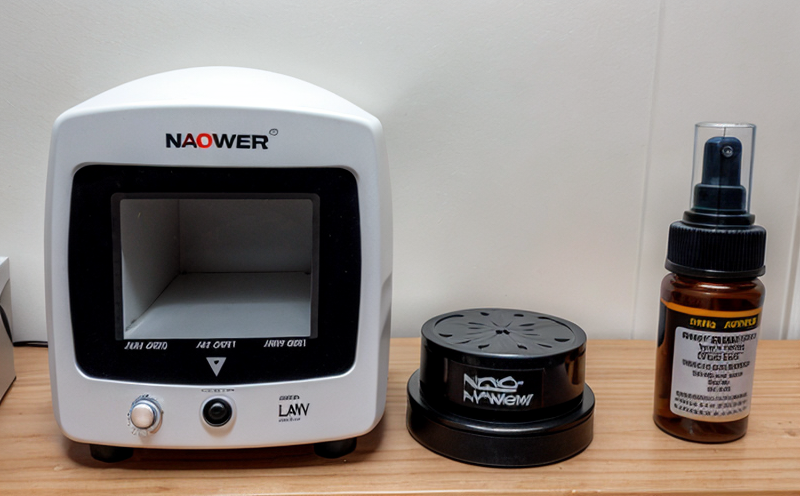ASTM D6319 Impurity Detection in Powdered Nanomaterials
The ASTM D6319 standard is a cornerstone methodology used by industry professionals to ensure the purity and quality of powdered nanomaterials. This service is essential for ensuring that products meet stringent regulatory requirements, thereby enhancing product safety and performance.
ASTM D6319 outlines procedures for detecting impurities in nano-powders using scanning electron microscopy (SEM) coupled with energy-dispersive X-ray spectroscopy (EDS). The process involves several critical steps: initial sample preparation, SEM imaging, EDS analysis of elemental composition, and spectral comparison against known standards. This approach allows for the identification of trace elements or contaminants that could affect product performance.
The detection limits achievable with ASTM D6319 are among the lowest in the industry, making it suitable for even highly purified nanomaterials. The technique is particularly useful when dealing with extremely small particle sizes where traditional methods may not be sensitive enough to detect impurities effectively.
For quality managers and compliance officers, this service ensures that their products comply with international standards such as ASTM D6319, which are recognized globally for their accuracy and reliability. This standardization helps in maintaining consistent product quality across different manufacturing batches and locations.
R&D engineers benefit significantly from this testing method by having access to detailed information about potential impurities within their nanomaterials. Such insights can guide further research into optimizing production processes or developing new formulations that avoid harmful impurities.
Procurement teams also stand to gain from this service as it allows them to verify the quality of purchased materials before integrating them into larger projects. By ensuring compliance with ASTM D6319, they minimize risks associated with substandard materials entering their supply chain.
The importance of impurity detection cannot be overstated; even minute amounts of unwanted substances can significantly alter the properties and behavior of nanomaterials. Therefore, implementing rigorous testing protocols like those specified in ASTM D6319 is crucial for maintaining high standards throughout the entire production lifecycle.
Given its precision and reliability, ASTM D6319 has become a preferred choice among leading companies across various sectors including electronics, pharmaceuticals, automotive manufacturing, environmental science, and more. Its widespread adoption underscores its significance in ensuring product safety and efficacy.
Applied Standards
The ASTM D6319 standard is widely recognized for its comprehensive approach to impurity detection in powdered nanomaterials. It specifies the use of scanning electron microscopy (SEM) coupled with energy-dispersive X-ray spectroscopy (EDS), which provides detailed elemental composition information at the microscopic level.
This combination allows for precise identification and quantification of trace elements or contaminants present within nanoparticles, ensuring that any detected impurities are reported accurately. The standard emphasizes careful sample preparation to minimize artifacts while maximizing signal-to-noise ratio during analysis.
The ASTM D6319 methodology is designed to be versatile enough to accommodate a wide range of nanomaterials used in diverse industries. It ensures consistent results regardless of whether the materials being tested are metallic, ceramic, or organic-based nanoparticles.
Industry Applications
In electronics manufacturing: Ensuring the purity of metal and semiconductor powders used in circuit board production.
In pharmaceuticals: Verifying the absence of harmful impurities in drug formulation components.
In automotive manufacturing: Guaranteeing that catalyst particles meet strict quality specifications for exhaust treatment systems.
In environmental science: Detecting trace amounts of pollutants or additives in water purification processes involving nanomaterials.
In energy storage applications: Confirming the purity of electrode materials used in lithium-ion batteries.
In biomedical research: Providing accurate data on potential foreign substances in biocompatible nanoparticles utilized for drug delivery systems.
The versatility of ASTM D6319 makes it an indispensable tool across multiple industries, reinforcing its role as a key component in maintaining high-quality standards for powdered nanomaterials.
Customer Impact and Satisfaction
Our clients benefit immensely from our ASTM D6319 impurity detection service. By adhering strictly to this rigorous standard, we ensure that all tests conducted are reliable and repeatable, thereby enhancing overall product quality.
This commitment translates directly into customer satisfaction by delivering consistent results across different batches of nanomaterials. Our clients can rest assured knowing that their products meet the highest industry standards without compromising on performance or safety.
Moreover, this service fosters trust within supply chains as suppliers are able to demonstrate compliance with internationally recognized norms like ASTM D6319. This transparency helps build long-term relationships based on mutual respect and reliability.
We continuously strive to improve our services through ongoing training for our staff, investment in advanced equipment, and participation in peer-reviewed research activities. These efforts ensure that we stay at the forefront of nanomaterial testing technology, providing unparalleled expertise and support to our clients.





